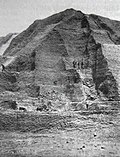Phosphorus
Phosphorus has the chemical symbol P, and its atomic number is 15. Its mass number is 30.97. It is not found in nature as an element, but as compounds, such as phosphates. There are many different forms. The most common form is a red or white waxy solid.
Properties
Physical properties
Phosphorus comes in several forms. White and red phosphorus are the most common forms. White phosphorus is a waxy white solid. When pure, it is colourless. It is insoluble in water, but soluble in carbon disulfide, an organic solvent. It turns light yellow when in air. It glows in the dark because it "burns" very slowly in air.
When exposed to sunlight, or when heated in its own vapour to 250 °C, it is converted to the red variety. This form does not ignite spontaneously and it is less toxic and less flammable than white phosphorus. The red modification is fairly stable and sublimes with a vapor pressure of 1 atmosphere at 417 °C.
Chemical properties
White phosphorus is more reactive than red phosphorus. White phosphorus catches fire spontaneously in air, burning to make smoke of phosphorus(V) oxide. If it burns in a little air, it produces poisonous phosphorus(III) oxide. When white phosphorus is heated in an alkali, it disproportionates to produce hypophosphites and phosphine. Red phosphorus can burn but needs to be ignited. Phosphorus reacts with the halogens to make phosphorus halides. It reacts with some metals to make phosphides.
Chemical compounds
Phosphorus compounds are chemical compounds containing phosphorus. They are listed below with some of their properties. Phosphorus comes in several oxidation states, the number of electrons moved during a redox reaction. -3 is flammable, powerful reducing agent, and toxic; +1 is a strong reducing agent and is rare; +3 is a weaker reducing agent that is poisonous; +5 is not a reducing agent and is very common.
In -3 oxidation state
Phosphides
- Phosphine, toxic gas that smells like fish and ignites by itself
- Phosphide, the ion
- Sodium phosphide
Other compounds
- Phosphorus(V) oxide, phosphorus pentoxide, absorbs water
- Phosphorus(V) chloride
In +1 oxidation state
- Hypophosphorous acid, salts are called hypophosphites
- Sodium hypophosphite
In +3 oxidation state
Phosphites
- Phosphorous acid, poisonous, salts are called phosphites
- Sodium phosphite
In +5 oxidation state
Phosphates
- Phosphoric acid, most common, salts are called phosphates
- Calcium phosphate
- Dicalcium phosphate
- Monocalcium phosphate
- Sodium phosphate
- Zinc phosphate
Occurrence
It is an essential component of living systems and is found as phosphate in nervous tissue, bones and cell protoplasm. It is also found in the earth as phosphate rock. Phosphate rock is the main source of phosphorus and phosphorus compounds. Many body tissues have calcium phosphates in them.
Preparation
Phosphorus was first made by heating a mixture of phosphates and carbon in an iron pot. The phosphates were made by dissolving bones in strong acids and evaporating the solution.
Phosphorus is made now by heating calcium phosphate, carbon, and silicon dioxide in an electric arc furnace. The heat of the electric arc melts the mixture of materials, and phosphorus gas is given off. It is absorbed under water. This makes white phosphorus.
Uses
As an element
White phosphorus is used in incendiary weapons and smoke grenades. It is also used to make organic compounds that have phosphorus in them. Phosphorus is used to dope semiconductors. Phosphorus is used to remove oxygen from copper. It is also used in making alloys. Red phosphorus is used in matches and flares.
As chemical compounds
Phosphorus compounds are used for fertilizers, soft drinks, toothpaste, and detergents. Most of these are phosphates. Phosphides can be used to kill rodents.
Safety
White phosphorus is very dangerous. It is very toxic and ignites easily, burning with a very hot flame. Red phosphorus is much safer. Some phosphorus compounds are toxic, but the common phosphates are not toxic.
Phosphorus Media
The Alchemist in Search of the Philosophers Stone (1771), by Joseph Wright, depicting Hennig Brand discovering phosphorus.
Guano mining in the Central Chincha Islands, c. 1860
A worker tends an electric phosphate smelting furnace in Muscle Shoals, Alabama, 1942
Mining of phosphate rock in Nauru
A phosphate train on its way to the port of Casablanca in Morocco.














